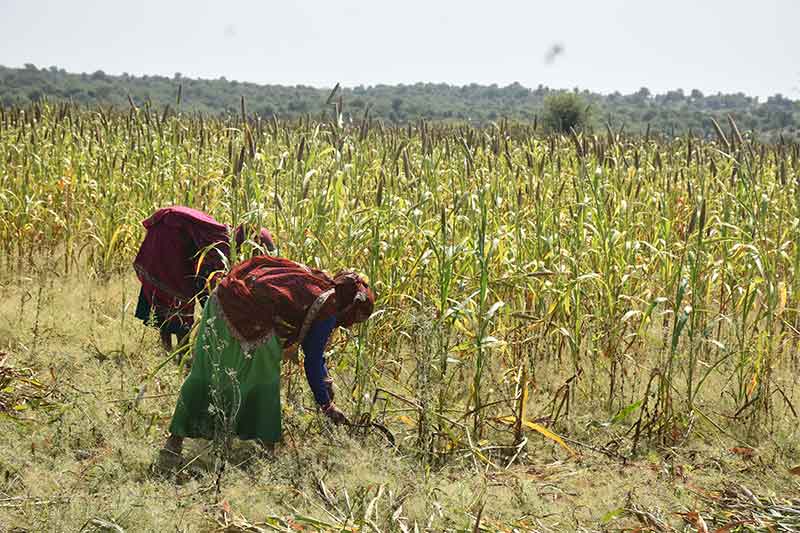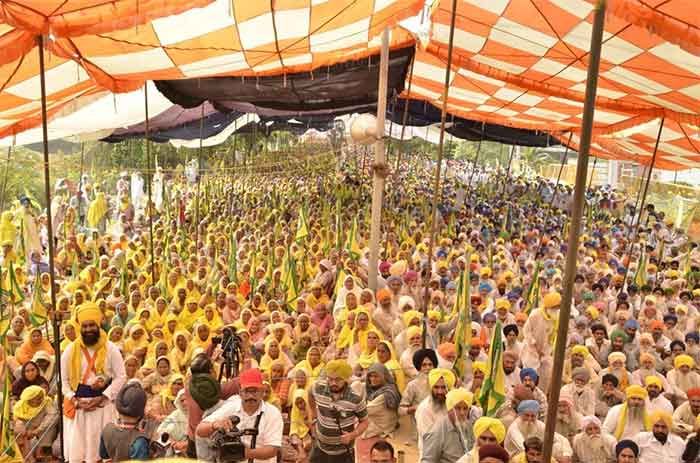
It has been 75 years since India gained independence, yet women in agriculture continue to face systematic marginalization, lacking the formal recognition and status of “women farmers.” Women bear a double burden as they not only work tirelessly in agriculture but also take on the responsibility of caring for their families, ensuring their well-being and managing household needs alongside their farming duties. Despite their immense contribution, women face systemic challenges deeply rooted in a patriarchal society. Gender discrimination and rigid social norms often push them into low-paying or unpaid work, undervaluing their efforts. Additionally, their limited access to education, healthcare, and basic services makes their situation even more difficult and deepens their marginalization.
Agriculture is the main source of income for around 70% of households and provides jobs for nearly 60% of the national workforce. About 80% of rural women depend on agriculture for their livelihoods. Women make up 33% of the agricultural labor force and nearly 48% of self-employed farmers in India.Most farmers in rural areas are small and marginal, with limited land that can’t even provide enough for three meals a day. As a result, the male members often migrate to urban areas in search of work, as industries are located far from their villages. This increases the responsibility of women, who are left to manage all the agricultural activities on their own. They were even involved in allied activities like livestock rearing, horticulture, and post-harvest operations. They perform hard, manual tasks such as milking, threshing, winnowing, and collecting fodder. Despite their important contributions, they face unfair treatment, including lower wages and a lack of recognition as farmers, which limits their economic potential. They still do not have decision-making power over crops or livestock or autonomy in agriculture production.
One of the biggest challenges women in agriculture face is the lack of land ownership. Although 85% of rural women are involved in farming, only 13% own land because land titles are rarely in their names. This lack of ownership not only prevents them from being recognized as farmers but also stops them from accessing loans and government support. According to the Food and Agriculture Organization (FAO), closing the gender gap in land ownership could increase farm productivity by 30% (FAO, 2022). Additionally, women’s work in agriculture is often undervalued, with most of their tasks considered unpaid labor. Studies show that female agricultural workers and farmers are often given less-skilled jobs, such as sowing, transplanting, and weeding, and are paid 20.69% less than men counterparts (Report on agricultural statistics released by the Minister of Agriculture and Farmers’ Welfare, 2019).
In rural areas where water is scarce, women face even greater challenges. Agriculture in rainfed regions is like trying to make bricks without straw—farmers struggle to grow crops with limited water. Women often don’t have enough water in their borewells for drinking and have to walk kilometers to fetch water, carrying it on their heads. This heavy workload makes farming an even bigger burden for them. Their daily routine is so demanding and packed with tasks that they hardly have any time for themselves. The lack of proper toilets and sanitation facilities also puts women’s health at risk. They are often not aware of the importance of taking care of their health, which leads to serious health problems and affects their overall well-being.
In rural India, women’s mobility is significantly limited compared to men. They rarely travel independently and usually only do so for family functions, such as weddings, often requiring permission from their husbands. Despite being deeply involved in agricultural activities, women have little say in key decisions. They are rarely consulted when purchasing farming inputs like seeds or deciding where and how to sell the produce in the mandi or markets. Their contributions remain undervalued, even though they play a crucial role in planting, weeding, harvesting, and other labor-intensive tasks essential to farming.
Amid the climate change crisis, the role of women becomes even more important. Uneven rainfall and global warming are pushing farmers to adopt alternative, climate-resilient agricultural practices, which are more labor-intensive and require additional time. This means that women, who already have very little time for themselves, will have to devote even more energy to their work in order to adapt to these changes.
Bringing about behavior change and altering land ownership is a challenging task that requires both strong determination and time. While the government often talks about “nari shakti” and empowering women, real change is not happening as quickly as it should. However, various grassroots organizations are making a significant impact. They are building community institutions at the local level, such as developing federations and FPOs and bringing leadership among women. As a result, women are breaking free from traditional constraints, challenging patriarchal norms, and demanding their rightful share of resources and opportunities.
Recognizing the importance of involving women in commercial farming, the government has been working to connect agriculture with community platforms through various policies. Self-help groups (SHGs) and farmer-producer organizations (FPOs) have become essential platforms to boost women’s economic participation in agriculture.
Subscribe to Our Newsletter
Get the latest CounterCurrents updates delivered straight to your inbox.
Despite these efforts, women still have a long way to go to achieve gender equality as envisioned in the constitution and promoted through SHGs. Gaining formal recognition as “women farmers” is a crucial step toward breaking the centuries-old shackles of inequality. While change is gradual, there is hope that one day these barriers will crumble, paving the way for a more equitable and inclusive society where women can fully realize their potential in agriculture and beyond.
Uday Kumar Saw is a Project Executive at Self-Reliant Initiatives through Joint Action (SRIJAN), where he helps rural communities become self-sufficient through sustainable change. He holds a Master of Arts in Social Work, specializing in Social Development, from Jamia Millia Islamia University, New Delhi.
















































